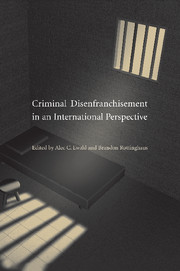Book contents
- Frontmatter
- Contents
- Contributors
- Foreword: Waves of Democracy and Criminal Disenfranchisement
- Acknowledgments
- Introduction
- Part I CONTEMPORARY DISENFRANCHISEMENT LAW
- Part II DISENFRANCHISEMENT IN COMPARATIVE PERSPECTIVE: LEGAL AND POLITICAL APPROACHES
- Part III VOTING RIGHTS AND PEOPLE WITH CRIMINAL CONVICTIONS: CASE STUDIES
- Index
- References
Introduction
Published online by Cambridge University Press: 03 July 2009
- Frontmatter
- Contents
- Contributors
- Foreword: Waves of Democracy and Criminal Disenfranchisement
- Acknowledgments
- Introduction
- Part I CONTEMPORARY DISENFRANCHISEMENT LAW
- Part II DISENFRANCHISEMENT IN COMPARATIVE PERSPECTIVE: LEGAL AND POLITICAL APPROACHES
- Part III VOTING RIGHTS AND PEOPLE WITH CRIMINAL CONVICTIONS: CASE STUDIES
- Index
- References
Summary
Addressing graduates of Southern Cross University in New South Wales, Australia, in September 2007, Justice Michael Kirby of the High Court of Australia spoke of law, justice, and Australian citizenship. He also chose to talk about one recent case: Roach v. Electoral Commissioner. Earlier that same week, he told the gathering, his Court had taken “the always serious and solemn step of invalidating an Act of the Federal Parliament.” The 2006 statute in question, Justice Kirby explained, had denied all serving prisoners the right to vote, extending the previous law barring from participation only those serving sentences longer than three years. As Justice Kirby said that day, in Roach, the Australian Court noted that Canada's Supreme Court had struck down a ban on prisoner voting in 2002, followed by a similar decision in the European Court of Human Rights (ECHR) in 2004. By contrast, the U.S. Supreme Court had let stand state laws that kept millions from the polls “for life.” Kirby quoted Canada's court: In setting the rules for who may and may not vote, “a community takes a crucial step in defining its identity.” In addition, he sharply criticized American law, saying that “[u]nlike the United States,” Australia “would never tolerate excluding millions (or thousands) of citizens from the vote because of past convictions.” Finally, Justice Kirby noted that Vicky Roach was an Aboriginal and had based part of her challenge to the disenfranchisement statute on its impact on indigenous citizens (Kirby 2007: 5, 6, 9).
- Type
- Chapter
- Information
- Publisher: Cambridge University PressPrint publication year: 2009

